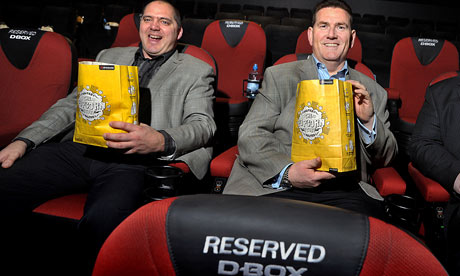
The first audible "oh!" came less than a minute in. On screen, an aerial battle was raging above the planet Barsoom, and in the middle of screen 11 at Cineworld in Glasgow, city centre Alana Porter and her 12-year-old son, Nathan, were shaking in their seats.
The pair were among a small group of movie buffs to try out what is claimed to be the UK's first 4D cinema experience, at a screening of the Disney action film John Carter.
Thirty-five of the shifting and vibrating D-BOX seats have been fitted in the Glasgow cinema, the UK's busiest. Five more British cinemas will get the technology in coming months, including the O2 Greenwich, and 24 more at a later stage.
"At first, I thought, ooh, what's coming next?" said Porter. "But it does help you feel part of the action."
It's not the first time the film industry has experimented with an extra dimension. Scent and motion have been used, with limited success, to heighten cinemagoers' experiences since the 30s. In 1959, the director William Castle used vibrating devices in cinema seats for his horror film The Tingler and in 1981 John Waters used scratch-and-sniff cards for his "Odorama" comedy, Polyester.
The UK launch of the 4D seat comes in the same week a report said 3D may be losing its lustre, with box office receipts down on previous years.
But Matt Eyre, Cineworld's vice president of operations, says 3D is here to stay and claims 4D seats are not a gimmick but a logical progression.
"This is the next step. I think filmgoers are always looking for that little bit extra."
The seats will add £5.50 to the £8.90 cost of the average 3D ticket. They will form about 10% of the seating in theatres selected for 4D. "It's a choice at the end of the day," said Eyre. "We have VIP boxes, for example. This is another evolution."
Most of the 3,000 existing D-BOX seats are in the US and Canada, with others in Japan, Germany, Australia and New Zealand.
Guy Marcoux of D-BOX said his firm worked closely with film studios' motion designers at the post-production stage to match seat movements frame by frame to action. There can be 30 separate movements in a frame and the process can take 200-600 hours per film.
"We are trying to reflect everything you would feel in real life without crossing that line of being like a theme park ride," he said. "We are trying to get a mix between motion and emotion."
Philip Drake, of Stirling University's school of film and media studies, said the 4D seats were an interesting idea but unlikely to become widespread and replace traditional seating because of the cost of retrofitting cinemas.
"It is an odd name for what might be better called haptic [relating to the sense of touch] cinema," he said. "After all we all know time is the fourth dimension … I can't see this having legs outside of specialist premium seats … and I'm not sure that people want that kind of sensory feedback that this will give. Do people want popcorn shaking all over them when they're watching an action movie?"
Beth Wood had to hang on to her snacks during one particularly frenzied action sequence in the Glasgow screening. "There was a bit where I thought it was not going to move and it did and I almost got a fright," she said. "But I don't think I would have seen this film without it. It does add something."
Staff at the launch pointed out the seats' individual controls, which can be turned up, down or off. There have been 10,000 D-BOX screenings they said and, as yet, no one has been sick.

